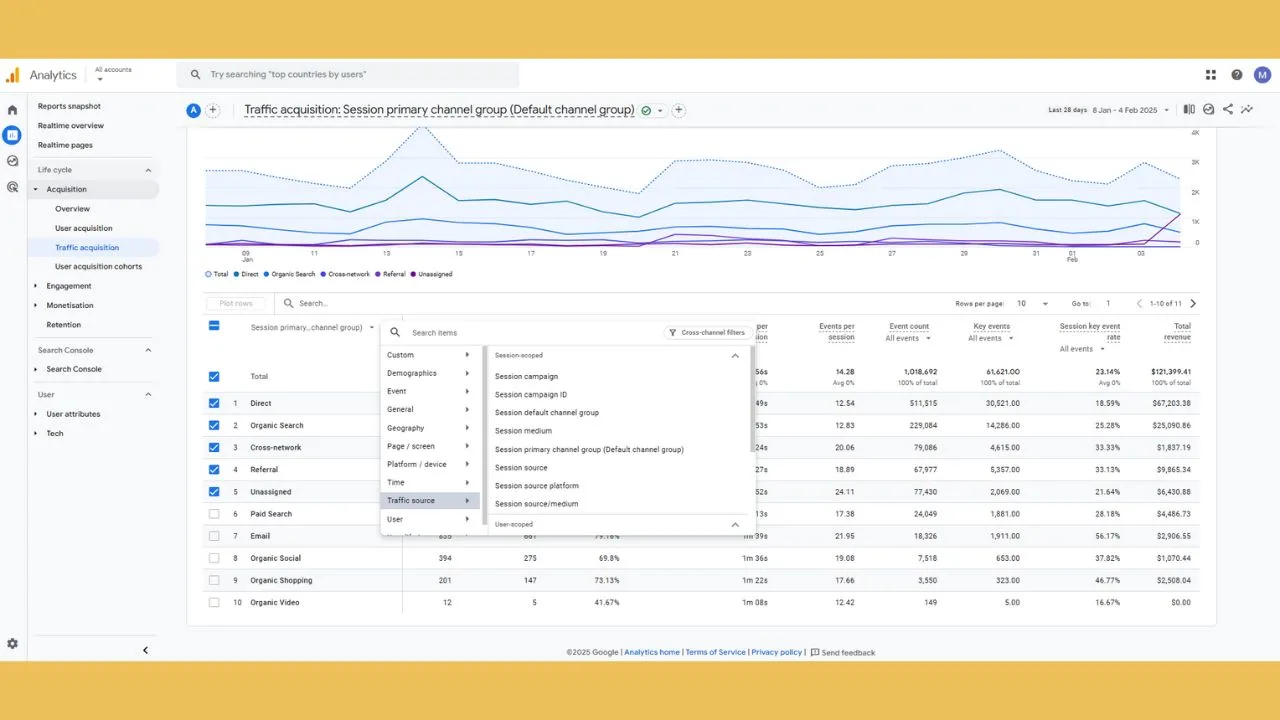How to track UTM parameters in Google Analytics 4? Cross-tracking the UTM parameters in Google Analytics 4 (GA4) is the practice for judging the effort of marketing campaigns. UTM means Urchin Tracking Module, and it is a small snippet that can be added up to a URL. This tags the businesses for tracking the sources of traffic and the engagement of users at much finer levels, thus enabling more detailed insights on the performance of the campaigns. So when UTM is configured in GA4, marketers generate important data to make changes where needed and improve the same campaign’s results.
These parameters include source (Google, Facebook), medium (email, CPC), the campaign (Summer_Sale2024), content, and term. Each can directly answer different important queries such as: Where is traffic coming from? What campaign drove that? Is it performing better than any other effort? Because today, if online is the world, brand owners want to keep track of these metrics, as they would prove vital to successfully marketing their brands.
What Are UTM Parameters?
UTM parameters are URL-based tags that monitor the performance of campaigns. These tags help marketers analyze traffic sources at a very granular level and find out what works best. Some of the general UTM parameters are:
- Source: This one shows from where (e.g., Facebook, Google) the traffic is heading in.
- Medium: Is a parameter of how the type of traffic comes (for example, email, organic, CPC).
- Campaign: Tracks the specific marketing campaign (e.g., Black_Friday_2024).
- Content: Differentiates ads within a campaign.
- Term: Used for paid search keywords.
These parameters are essential for detailed reporting in GA4, ensuring clarity about which campaigns drive traffic and conversions.
Why UTM Tracking is Essential for GA4
Google Analytics 4 is indeed a step ahead of Universal Analytics. It offers newer features like event-based tracking and better machine-learning integrations, which will improve understanding about user behavior and campaign performance. With GA4 leveraged against UTM tracking, businesses are now set to build strong pillars for analyzing their marketing performance. That’s especially interesting for wordpress website development services or B2B web design agency that measure campaign ROI and develop strategies accordingly.
The use of UTM parameters in Google Analytics 4 will also help in real-time monitoring of the campaign. The company can quickly see how well their efforts are doing and make improvements on-the-fly for better results. Moreover, one of the strengths of GA4 is sophisticated attribution modeling, which identifies high-performing channels for the company to assign resources in an intelligent way towards marketing. From the perspective of businesses that seek to optimize such platforms as Shopify, understanding how UTM tracking delivers worthwhile visibility will be perfected by strategy improvement on the SEO for shopify bradford.
These insights will provide a source of the best value for businesses that want to become stronger online. As the fight intensifies in terms of precision and clarity, such businesses will have a few underdogs proven to win rounds ahead in this digital turf.
Unlock the Power of UTM Tracking
Take your analytics game to the next level
Also Read: Add The Google Analytics Code to Your Canva Website
How to Set Up UTM Tracking in GA4
To begin, you need to create URLs with UTM parameters. Google’s Campaign URL Builder is an easy-to-use tool for this purpose. For example, if you’re running a Facebook ad promoting a spring sale, you might create a URL like:
arduino
Copy code
Once you’ve created your UTM-tagged links, integrate them into your campaigns. Replace standard URLs in email marketing, social media ads, or PPC campaigns with these tagged versions. When users click these links, GA4 captures the UTM data and associates it with their session.
To view UTM performance in GA4, navigate to the Acquisition > Traffic Acquisition report. Here, you can analyze data by source/medium, campaign name, and other dimensions. These insights will reveal which campaigns are driving the most traffic and conversions, providing actionable data to refine your strategies.
Analyzing UTM Performance in GA4
Google Analytics 4 (GA4) truly opens up a lot of opportunities for tracking UTM-identified data and analyzing it for campaign results. The most important report for this purpose is the Traffic Acquisition report, which has made it possible to track UTM parameters. When filtering based on either campaigns or sources of data, user behavior can be tracked with respect to metrics like the number of engaged sessions, average session duration, and conversion rates. Incredibly important for identifying those successful campaigns or anything else in need of improvement.
In a truly insightful use of GA4, its Custom Exploration Reports are very important for being able to get a business to picture user journeys, dropping points, and all high-potential campaigns. For example, if a particular high-performing source campaign drives more session duration and engagement, all those strategies may be replicated for success in the future. These tools come in quite handy in solving issues regarding the entire Google Analytics audit checklist so that the tracking setup becomes detailed and correct.
Conversion and bounce rates are some of the most insightful metrics. Because if a campaign has a high conversion rate and a low bounce rate, it means that the campaign was optimized well. The other part of a high bounce rate shows that the expectations of such users are quite different. Businesses could learn about these metrics to improve targeting in campaigns and better optimize the landing page. This is especially important as it relates to average cost of website design for small business, what is a secondary dimension in google analytics and what effective campaigns do for ROI.
Knowing how to track UTM parameters in Google Analytics 4 will help developments in decision making, enabling companies to streamline marketing campaigns while being able to measure growth.
Also Read: What is Cross Network in Google Analytics
Best Practices for Effective UTM Tracking
Consistency is key when using UTM parameters. Adopt standardized naming conventions to avoid data discrepancies. For instance, decide whether to use “cpc” or “CPC” as your medium and stick to it across all campaigns. This ensures that GA4 consolidates data effectively, making your reports more accurate and actionable.
Another best practice is to test your UTM-tagged links before deploying them. Broken links or incorrectly configured parameters can lead to lost data, undermining your analytics efforts. Using URL shorteners can also help maintain a clean, professional appearance in your campaigns, particularly for social media.
For automation, consider integrating GA4 with Google Tag Manager. This streamlines the tagging process, especially for large-scale campaigns, and ensures consistent tracking. Tools like Google Tag Manager are especially useful for managing dynamic UTM parameters in e-commerce settings, where products and promotions frequently change.
Ready to Boost Your Campaigns?
Let’s Simplify UTM Tracking for You
Common Challenges and Solutions
One frequent challenge in how to track UTM parameters in Google Analytics 4 is the inconsistency in naming conventions. For an example, using “fb” in one campaign and using “Facebook” in another can fragment your data, creating problems in analysis. Start working coherently as a team by establishing a common UTM tagging guideline for everyone to adopt.
Another issue is that too many UTM parameters have sensitive information, which may infringe local privacy regulations. Always ensure URLs comply with data protection laws like GDPR to avoid getting penalties. As a best practice, anyone can remove PII from UTM links.
Moreover, neglecting landing page optimization is common for marketers. No matter how much UTM parameters trail thousands of visitors, a badly designed landing page would cause exit after only a few seconds or minutes. A regular audit of your landing pages lets you usually control their responses and check if they meet target expectations for campaigns to maximize your Google Analytics 4 efforts.
Enhancing UTM Tracking with Additional Services
To fully leverage UTM tracking, consider integrating it with broader web services. delete google analytics account, website maintenance services ensure that your UTM-tagged pages load quickly and function properly. Similarly, responsive website development services help create mobile-friendly landing pages, ensuring a seamless experience for users arriving via UTM links.
For advanced tracking needs, google analytics consulting services or google tag management consulting services can help you set up customized reports and streamline your analytics workflow. Businesses using Shopify can also benefit from shopify maintenance services, which ensure that UTM tracking is seamlessly integrated into their e-commerce operations.
Also Read: How to Delete An Account On Google Analytics
Conclusion
Understanding how to track UTM parameters in google analytics 4 is essential for modern digital marketing. The use of UTM tracking provides businesses with insights into campaign performance, user behavior, and traffic sources unlike any other. With its platforms solid and deep, GA4 takes measure of what counts and fine-tunes your strategies for maximum effect.Visit website redesign services and what is checked in a google analytics audit to get the best tracking setup, add the google analytics code to your canva website and WordPress development services. Master UTM tracking, and you’ll be all set to drive change through data in achieving your marketing goals.
FAQ’s
How to track utm parameters in google analytics 4?
Next in line of the process is getting their measurement in GA4. Before you begin the measurement, ensure your URLs contain UTM codes: utm_source, utm_medium, and utm_campaign. Then open the Reports section of GA4 and head for Acquisition > Traffic Acquisition. You will find it in there that specifies parameters like the number of sessions or conversions captured per each UTM code.
For those needing customized insights into a specific campaign or channel, use the GA4’s Explorations feature to build custom requisition reports. It is also helpful to have consistent naming standards as well as organism-compliant data (GDPR-compliance) for effective UTM tracking. Good tracking is an optimistic measure for the performance of the campaigns and well-haired sophistication of marketing strategies.
How do you track UTM parameters in GA4?
To track those parameters in Google Analytics 4 (GA4), the first step is to tag your URLs with UTM parameters: utm_source, utm_medium, and utm_campaign. The next step is to go to the Traffic Acquisition report under Acquisition in GA4. From here, it can be observed how much each of your UTM tags drives traffic. You can even create custom reports based on Exploration for more specific analysis regarding the campaigns. It is very important to have consistent naming conventions of UTM parameters and have a proper understanding of data privacy regulations like GDPR for accurate and correct data tracking as well.






Leave a Reply